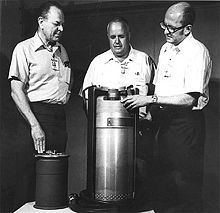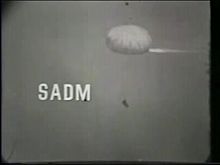Atomic Demolition Ammunition
Atomic Demolition Munitions ( ADM ) are tactical nuclear weapons . Atomic mines , nuclear mines or nuclear land mines are also often used . These nuclear explosive devices are installed at a certain point and detonated remotely / timed.
General
ADMs were available in sizes from 10 t (equivalent to TNT) to 1 kt (Small ADM, SADM) and 500 t to 15 kt (Medium ADM, MADM). Class W54, for example, weighs less than 74 kg and has an explosive force between 10 t and 1000 t. In 1985, 93 pieces of this weapon are said to have been operational in Europe. Other sources speak of around 300 ADM in 1985 in West Germany.
The purpose of this weapon is the extensive blocking of points in the area in order to delay an enemy attack. If the Warsaw Pact were to attack Western Europe, these weapons would be on the inner-German border and in areas beyond it, such as B. Fulda , the so-called Fulda Gap , was used. For this purpose, the bombs would have been brought to critical points with many traffic routes or strategic, critical infrastructure (such as in the Hattenbach area near Fulda or under runways) in order to destroy the paths in the event of their explosion and thus hinder the advance of the enemy ( Zebra Package ).
Other possible areas of application were tunnels, motorways, dams and bridges. The explosion would have been initiated using a remote detonator, for example. Exact areas of application are still subject to confidentiality today .
The background to these plans was the superiority of the conventional armed forces of the Warsaw Pact at the time. Withstanding an attack by the Eastern Bloc with conventional weapons was not possible due to the balance of power. Therefore, NATO reserved the right to stop such an attack with nuclear weapons. In addition to the ADM, nuclear-armed short-range missiles were also planned.
German commanders had a psychological problem with the use of ADMs on German soil, as the consequences could not be calculated. In 1960, German officers refused to use tactical nuclear weapons such as ADM during the pioneer exercise MAKE FAST VIII, which led to irritation among the British, Dutch and Belgian participants. However, the Bundeswehr leadership had to give in to NATO demands and include the ADM in the defense planning and sound out appropriate deployment points. As a concession on the part of NATO, ADMs should only be used east of the Weser and not in or near localities. However, the US was unwilling to delegate the clearance of the ADM to the military leaders on the ground. As a result, they lost their operational value, as they could not be deployed quickly enough and were ultimately removed from NATO's then secret deployment plans in the mid-1960s by Count von Kielmansegg , the first German CINCENT .
From 1969, Helmut Schmidt was defense minister against the use of nuclear mines and prevented the planned mining from being implemented.
ADMs and short-range nuclear missiles such as the French Pluton were discussed critically in the German public in the 1970s and 1980s, as they would have been used on the alleged battlefield of Germany.
After the peaceful revolution in 1989, these weapons lost their military importance. The removal of the military threat posed by the Warsaw Pact also eliminated the scenario of a surprise attack by a superior conventional army. Both short-range nuclear weapons and ADM had lost their importance and planned use.
The Soviet Union also had such weapons. However, due to the already existing conventional superiority, they had no major strategic importance there.
American ADM types
| designation | In service | description | |
|---|---|---|---|
| from | to | ||
| W7 / ADM-B | around 1954 | 1967 | |
| T4 / ADM | 1957 | 1963 | Modified version of the W9 nuclear artillery shell |
| W30 / Tactical Atomic Demolition ammunition | 1961 | 1966 | Explosive power: 0.3 kilotons (Mod 4 Y1) or 0.5 kilotons (Mod 4 Y2) |
| W31 / ADM | 1960 | 1965 | Explosive power: 2 kilotons or less |
| W45 / Medium Atomic Demolition ammunition | 1964 | 1984 | Explosive power: Between 1 and 15 kilotons. |
| W54 / Special Atomic Demolition ammunition | 1965 | 1989 | Explosive power: Variable: 10 tons or 1 kiloton |
See also
- Blue Peacock , British Cold War nuclear weapons project
Web links
- Description of ADMs at sperranlagen.de, with picture
- Description of ADMs at Geschichtsspuren.de (formerly lostplaces.de)
- The Littlest Boy (Adam Rawnsley, David Brown)
Individual evidence
- ↑ a b c ADM - the so-called "atomic mine", geschichtsspuren.de (formerly lostplaces.de)
- ↑ a b c Keyword Joker . In: Der Spiegel . No. 3 , 1985, pp. 28-32 ( online ).
- ↑ a b Thoß, B .: Alliance integration and national defense interests. In: Nägler, F .: Die Bundeswehr 1955 to 2005, (Security Policy and Armed Forces of the Federal Republic of Germany, Vol. 7), Munich 2007, pp. 13–38.
- ↑ Explanations on the Fulda Gap and description of ADMs, fulda-gap.de
- ↑ The Wallmeister unit in the cold war: atomic bomb in the gully , Per Hinrichs: atomic bomb in the gully . In: Der Spiegel . No. 2 , 2008, p. 44-45 ( online ).
- ↑ Thoß, B .: NATO strategy and national defense planning, (Security Policy and Armed Forces of the Federal Republic of Germany, Vol. 1), Munich 2006, pp. 724f.
- ↑ Thoß, B .: "The more Bundeswehr the less atomic bombs", p. 127f., In: Bernhard, P., Nehring, H., (Ed.): Thinking about the Cold War, (Peace and War. Contributions to the historical Friedensforschung, Vol. 19), Essen 2014, pp. 103–130.
- ^ Helmut Schmidt: NATO planned nuclear mines in Germany . In: The time . December 12, 2009, ISSN 0044-2070 ( zeit.de [accessed August 6, 2016]).
- ↑ Helmut Schmidt in the foreword to: Detlef Bald: Politics of Responsibility. The example of Helmut Schmidt, Berlin 2008, p. 11.


